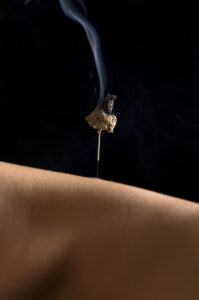


Boosting Immunity with Moxibustion
Boosting immunity with moxibustion is something that is of particular interest – and hopefully practical implication – at this time.
Moxibustion involves the application of a herb called mugwort which is burnt in a variety of possible methods for therapeutic purposes. Practitioners in China usually use a stick which is held over an acupuncture point or sometimes a broader general area. In Japan, a highly refined form of mugwort is applied directly to the body in very small quantities and lit. When used in this clinical setting, the mugwort is referred to as moxa. One particular strain, artemisia vulgaris latiflora, is generally used, and although the herb grows widely across large parts of the world, the strains commonly found in Europe are less well-suited to the practice.

In the clinic, moxibustion can be combined with acupuncture
It is in Japan that the most interesting research has taken place on moxibustion and its effect on the immune system. Going back a little further, there is documented evidence from Tang dynasty China in the seventh century of moxibustion being used as a preventative treatment to maintain wellbeing and health and also being used in the treatment of what was unquestionably tuberculosis. More recently in twentieth century Japan, the well-documented success of practitioners such as Fukaya and Sawada in the treatment of tuberculosis has stimulated so much research on boosting immunity with moxibustion.
One famous piece of research carried out by Dr Hara (who also practised on himself and lived to 108) in 1929 documents the application of moxa and the subsequent increase in leucocytes (disease-fighting white blood cells) which peaked at eight hours and remained high for three days after treatment.
The acupuncture point most commonly associated with treatment for boosting immunity with moxibustion is a point called Stomach 36 or Zu San Li, which translates as Leg Three Miles. While there is often debate and disagreement about the origins of the Chinese names for acupuncture points, one of the most common explanations of this point is that treatment here can strengthen a person to walk an extra three miles that day that they would not otherwise have been capable of.
Now a slightly more focussed exploration of the human immune system, which can be divided into two parts – the innate system and the adaptive or acquired system. The first of these is common across most life-forms, including plants and fungi. It is the adaptive immune system, which is unique to recently evolved vertebrates, that can play a major part in the defence against complex bacterial pathogens, such as tuberculosis, and complex viral pathogens, such as covid-19.
Two of the most important components of the adaptive immune system are T cells and B cells.
While considering the pathology (disease process) associated with covid-19 infection, it is essential that we bear in mind that scientific analysis and understanding of this new virus is literally in its infancy. It takes years of medical research to begin to understand a new pathogen such as this. However, there do seem to be certain observations that can be made at this stage. One of these concerns the functioning of the adaptive immune system, which is essential to fighting the illness. The amount of T cells decrease with age (as do B cells but it is not considered to be to a significant amount), and it is reasonable to see a link with the seriousness of infection in older people.
Moxibustion on the point Stomach 36 seems to have a significant role in stimulating immunological function – whilst also having a regulatory effect that also seems to benefit auto-immune conditions such as rheumatoid arthritis.
Whilst practitioners schooled in the Japanese acupuncture traditions would use moxa directly on the skin, and to be honest, research seems to suggest greater efficacy, I focus on using moxa sticks to warm Stomach 36 as taught in the Chinese schools. This is partly because that is the tradition in which I studied and also partly because I think it is far easier for people to do on themselves at home.
With either technique, the way the moxa is applied is vital. Warming Stomach 36 with extreme heat seems to stimulate the innate immune system. It is prolonged and gentle warming of the point that seems to stimulate the adaptive immune system with all the disease-fighting benefits this entails. Carrying out this treatment 2 – 3 times a week can be beneficial alongside other positive health choices at times of contagious disease. But when carrying out the treatment on oneself, it is key to stimulate the point so that it feels quite intensely warm but never allow it to get hot or unpleasantly warm as this will have the opposite effect. To some extent, the innate and adaptive systems dampen each other down, so heating the point in excess will inhibit the immune function needed to fight a virus.
While there are videos available of boosting immunity with moxibustion and showing how to use moxa sticks on yourself, it is always ideal to consult a practitioner first. One session with an acupuncturist will enrich you with a gift that you can use for the rest of your life.
As moxibustion involves lighting a herb that smoulders but does not burn, it is important to be aware of health and safety concerns. I always run through these with patients when I prescribe home application.
For information about the first of my clinics to open up following the lockdown, click here.
For further research on boosting immune function with moxibustion, check out this research.


